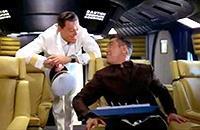2001: A SPACE ODYSSEY
TCM, 8:00 p.m. ET

Time machines are one of the most cherished tropes in the sci-fi genre – and though time machines to do not figure in either of the pivotal sci-fi films shown tonight as a double feature by TCM, they do allow us to take a time-machine trip of sorts. They allow us to watch, in sequence, futuristic films by two of their generation’s most innovative and influential filmmakers: Stanley Kubrick and George Lucas. So imagine you’ve just set your Wayback Machine, and start with 1968, when Kubrick befuddled and dazzled the world with his classic sci-fi trip, 2001: A Space Odyssey. When it premiered, and when I saw it that opening day, the actual year of 2001 was still 33 years in the future – a third of a generation away. One lengthy sequence involved a space shuttle to a lunar base, at a time when man landing on the moon was still a year away. And now, we’re close to 20 years removed from the actual 2001 – and so much of the science in the Arthur C. Clarke-Stanley Kubrick collaboration has held up amazingly well. 2001: A Space Odyssey made Kubrick a recognized and powerful auteur for the rest of his life – and with good reason. Watch from the start, with the lights off and the sound up, on as big a TV as you have. And then, after the climax, think and argue about it all over again.